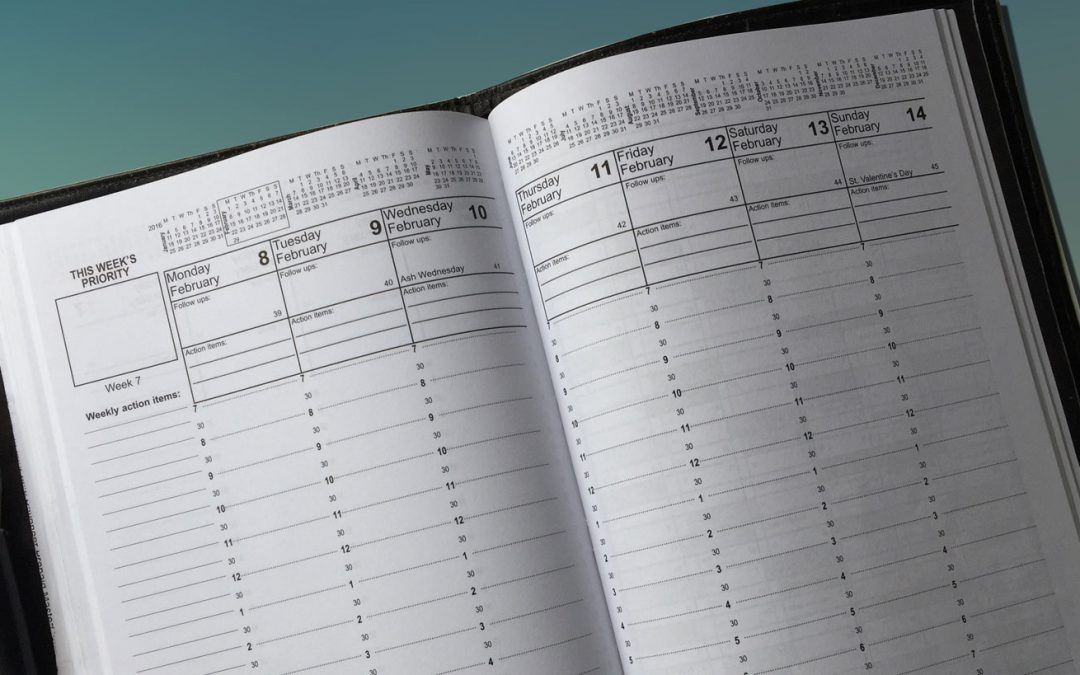
Research has discovered that deciding in advance when you will do something increases your commitment to do it. Adding something to a weekly list of things to do – even though they are only intentions – is better than simply being aware that something has to be done. But even more effective is to choose the specific time during the week that you plan to do something, and then block off that time in your planner as an “appointment with yourself.” Then you have a true commitment to get it done.
The problem is that you probably have more things to do during the week than you have the time in which to do them, plus you also can expect a series of unplanned interruptions and crises to disrupt your commitment even more.
The solution to these problems is not to throw up your hands and refuse to schedule anything for fear of having to postpone it, but rather to limit the number of tasks and activities that you schedule in your planner in any particular week. Most people underestimate the actual time it takes to complete a task. So allowing up to 50% more time than you think the task will take is not unreasonable.
Of course that will leave even less time to get everything done. So don’t plan to get everything done. Choose only the most important items – giving priority to those that are urgent as well as important.
Don’t block off all the available time in your work week. Block off anywhere from 20% to 80% of the available time, depending on the nature of your job. This not only allows for real crises and emergencies that are even more important than those you have already scheduled; it also allows time in the same week to reschedule any original priorities that may have had to be displaced in the process.
Assuming that only about half the available time in a workweek has been blocked off for appointments with yourself to get the really important things done, you may also be forced to schedule some of the jobs up to two weeks or more into the future. This makes it easier to make decisions when asked to commit time to work on additional tasks or to attend unplanned events or whatever. We tend to think we will have more time in the future than we have now. This simply is not true. The easiest way to say no is to have a reason to say no – by seeing future commitments already scheduled in your planner.
What about all the tasks that are not considered top priorities, but still have to be done? Add those to your To Do list; but make sure the list is a part of your planner, not a separate sheet of paper or electronic device. Your planner should list your goals, personal policies, To Do list and your actual schedule for the next week or more. These items are worked on during those snippets of time still remaining after having completed the scheduled tasks, and after any emergencies, and additional urgent priorities that cropped up during the week had been handled. If there is no such time left over, you must adjust the amount of time being allowed for the individual tasks or lower the percentage of your total week being allocated to current tasks.
Here is a summary of the essentials of effective planning using a planning calendar.
- Remember that items on a To Do list represent your intentions; but time actually blocked off in your planner to work on these items represent your commitment to get them done.
- Trying to focus on any project or task for too long a period of time depletes your energy, decreases efficiency, makes you more prone to error, and increases the likelihood of interruptions. Work on longer projects in blocks of time of 90 minutes or less with breaks in between.
- Always allow more time than you think the task will take to allow for any interruptions. You can use any time left over to work on your To Do list items.
- Don’t schedule your whole week. How many items you schedule depends on the nature of your job and your experience to date. If in doubt, test this strategy by scheduling only one or two items initially. If successful, gradually increase the number.
- Schedule time for only your top priorities, with the more urgent ones scheduled earlier in the week. Everything else can be added to your To Do list and crossed off when they’re done. But don’t spend time on To Do items if there are scheduled priority items still to be done.
- Only reschedule your priorities if items of even greater importance and urgency crop up in the meantime. Never postpone items simply because they can be delayed. Be prepared to say no. Have as much respect for your time as you have for other people’s time.
- Schedule both business-related and family and personal items in the same planner to avoid any conflicts. At the end of the year your planner will look like a journal your activities and accomplishments.
If you feel comfortable using a paper planner, take a look at the Taylor Planner described at taylorintime.com. It has the features needed to maintain control of your time by making commits to get things done.


Recent Comments